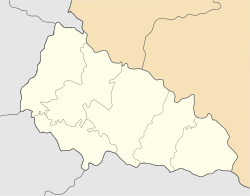|
Vynohradiv
Vynohradiv (Ukrainian: Виноградів, IPA: [wɪnoˈɦrɑdiu̯] ⓘ; Hungarian: Nagyszőlős; Romanian: Seleușu Mare; Slovak: Vinohradov) is a city in western Ukraine, in Zakarpattia Oblast. It was the center of Vynohradiv Raion and since 2020 it has been incorporated into Berehove Raion. Population: 25,317 (2022 estimate).[1] NamesThere are multiple alternative names used for this city due to its location and history: Hungarian: Nagyszőlős, Romanian: Seleușu Mare, Rusyn: Cивлюш (Syvlyush), Ukrainian: Cивлюш (Syvlyush), Russian: Виноградов (Vinogradov), Belarusian: Вінаградаў (Vinahradaŭ), Yiddish: סעליש (Seylesh, Selish), Slovak: Vinohradov (Veľká Sevljuš during Czechoslovak rule), German: Wynohradiw, Polish: Wynohradiw (hist. Sewlusz). GeographyLocationThe city lies near the river Tisza on the border with Romania. It is 35 kilometres (22 mi) from Berehove. HistoryIt was first mentioned in 1262 by the name Zceuleus. Its Hungarian name, Nagyszőlős ("Great Vineyard"), stems from the area being an important wine district. The city was called Sevlush (the Rusyn transliteration of the Hungarian word szőlős, meaning vineyard. The town was one of the oldest in Ugocsa county, and was inhabited by winemakers of the royal court. In 1329, Hungarian King Charles Robert granted privileges to the town, which became the seat of the Comitatus (the city held this rank until the Treaty of Trianon was signed in 1920). In 1717, most of the citizens of the town were killed by an invading Tatar horde. By 1880, the population was about 4,400 (with 500 native Romanians). In 1881 a secondary school was opened. In 1910 it had a population of 7,811 (5,943 or 76% Hungarians, 1,266 or 16% Ruthenians (Rusyns) and 540 or 7% Germans). The religious make-up was 3,311 Greek Catholics (42.5%), 2,237 Jews (28.6%) and 1,124 Calvinists (14.4%). This city had a Jewish ghetto in 1944. At its height from May to June 1944, most of the Jews of this section of northern Transylvania were deported to the Auschwitz concentration camp to be gassed shortly after arrival. Jews from the area typically spent about two weeks in the ghetto before being deported. Conditions were extremely cramped with many families housed in a single room, a deliberate arrangement meant to cause suffering and disease. In 1944, Carpathian Ruthenia was occupied by Soviet Union and was formally incorporated into Ukrainian SSR in 1946. The city name became Vinogradovo (Russian), Vynohradiv (Ukrainian), or Vynohradovo (Rusyn). All mean "Grape Town." A local newspaper is published here since December 1945.[2] Demographics According to the 2001 census, the population included:[3]
Tourist sights  
Notable peopleIn alphabetical order:
EconomyOne of the biggest employers in Vynohradiv is the Gentherm. International relationsTwin towns — Sister citiesVynohradiv is twinned with:
References
External links
|
||||||||||||||||||||||||||||||||||||||||||||||||||||||||||
Portal di Ensiklopedia Dunia




